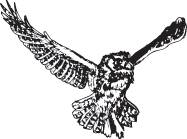

Barred Owl
(Strix varia)
Barred Owls have a large tuftless head and usually stand leaning forward.
They live in wooded groves, along streams and swamps. The skill with which they can maneuver in extremely dense forest and swamp growth, intricately weaving their way through the interlaced branches, is little short of miraculous. Their flight is smooth, extremely silent with slow-flapping and long glides. The Barred Owls habitat coincides with Red-shouldered Hawk and the two seem reasonably compatible.

A Barred Owl's eye is deep brown and seems small because of the concentric rings of dark brown encircling it on the facial disks. The Barred Owl's outer ear openings are complicated and asymmetrical in structure. The right ear is larger, opens upward and is tight to the facial disk while the smaller left ear opens downward and is back on the side of the face.
Their legs and feet are feathered to the base of the talons. Feet are rather small for an owl of this size and also not as strong as might be expected. Female Barred Owls are slightly larger than the males.
Barred Owls frequently bathe, with seeming delight, even in the midst of winter.
Barred Owls are the most vocal of all North American Owls and have the widest range of weird shrieks, screams, cries, trillings, grumbles, squeaks and hoots. Their territorial call is a series of hoots that sounds like "Who cooks for you, who cooks for you-all?"
Barred Owls are cavity nesters that breed in early March. They lay two to three white eggs that are incubated by the female. Because incubation starts immediately after the first egg is deposited in the nest, the hatching occurs at intervals over several days, asynchronously.
They have no distinct migration and normally are permanent residents within their range.
Crows and blackbirds mob the Barred Owls when they find them. Hunters shoot many Barred Owls, which is illegal and foolish because of all the pesky mice and rats Barred Owls prey on. Barred Owls often approach campfires and gas lanterns showing little fear of humans.